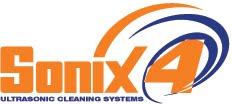It is important to consider certain aspects of the cleaning process in order to maximize cleaning efficiency and decrease the possibility of staff personnel exposure to pathogenic microorganisms.
Cleaning Solutions:
Cleaning solutions specifically formulated for ultrasonic cleaning and known to be compatible with the instruments to be cleaned are recommended to increase cleaning effectiveness and to protect the instruments from possible damage. Neutral or alkaline detergents are the most commonly used formulation that hospitals, surgical facilities, dental practices, and veterinarians use with ultrasonic cleaners.
Temperature:
Temperature of the liquid will affect both cavitation quality and the chemical cleaning action. Usually both can be improved by increasing operating temperature, however the cleaning solutions have a temperature point where they begin to break down, thus decreasing the cavitation and cleaning results. The optimum temperatures will vary according to the solutions physical properties, but as a rule of thumb most aqueous solutions cavitate best within the temperature range of 140-190 degrees Fahrenheit (60-88 degrees C), or as a general rule 2/3 the boiling point of the liquid. Beyond this optimum range cavitation will gradually decrease and at the boiling point cavitation will cease altogether. To avoid damage to the surgical instrument the temperature of the solution should not exceed the instrument's temperature parameters as recommended by the instrument manufacturer.
Since bacteria can proliferate in the ultrasonic cleaner's detergent solution its strongly recommended that the cleaning bath be changed often and regularly, and that a fresh volume of water be used for rinsing each new batch of instruments to minimize personnel exposure to potentially pathogenic microorganisms, to protect the instruments, and to prolong the life of the ultrasonic cleaner.
Accessories:
The benefits of ultrasonic cleaners can be maximized by using specially designed instrument baskets, trays, or cassettes. Accessories are crucial as they maximize exposure of the instruments to the direction of the ultrasonic waves, protect the instruments from damage abrading against each other during cleaning, and preventing the instruments from coming into contact with the bottom of the ultrasonic cleaner's tank which will cause damage to the unit. Accessories also provide protection for personnel minimizing the amount of instrument handling and potential injury.
Cleaning Cylce Time:
In addition to the type of cleaning solution used and the bath temperature, the cycle time needed to clean instruments will depend upon factors such as the load size - the number and arrangement of contaminated instruments, the degree of instrument contamination (e.g., lightly-soiled, heavily-soiled), as well as the frequency and power output efficiency of the ultrasonic cleaner.
In addition to increasing the productivity of reprocessing staff and minimizing the staff's exposure to contaminated instruments, ultrasonic cleaners have been shown to be substantially more effective and efficient than other methods for instrument cleaning whose results are often incomplete and unpredictable as they are unable to reach contamination in the hidden recesses that many of today's complicated surgical instruments possess.
Sonix IV Ultrasonic Cleaners have set the benchmark for cleaning and instrument reprocessing technology. For more than 38 years Sonix IV has been developing and manufacturing highly innovative ultrasonic cleaning products that address the need for versatility, flexibility, and efficiency in today’s environments.
Subscribe to:
Post Comments (Atom)


No comments:
Post a Comment